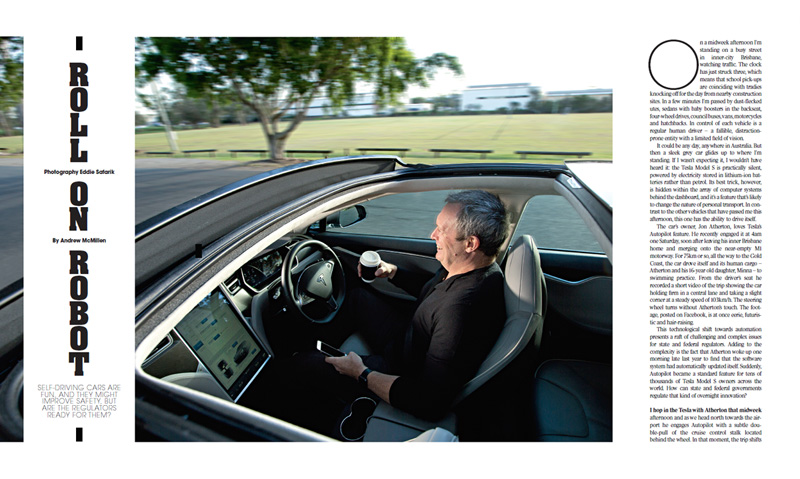The Weekend Australian Magazine story: ‘Roll On, Robot: Self-driving cars’, June 2016
A feature story for The Weekend Australian Magazine, published in the June 18-19 issue. Excerpt below.
Self-driving cars are fun, and they might improve safety, but are the regulators ready for them?
On a midweek afternoon I’m standing on a busy street in inner-city Brisbane, watching traffic. The clock has just struck three, which means that school pick-ups are coinciding with tradies knocking off for the day from nearby construction sites. In a few minutes I’m passed by dust-flecked utes, sedans with baby boosters in the backseat, four-wheel drives, council buses, vans, motorcycles and hatchbacks. In control of each vehicle is a regular human driver – a fallible, distraction-prone entity with a limited field of vision.
It could be any day, anywhere in Australia. But then a sleek grey car glides up to where I’m standing. If I wasn’t expecting it, I wouldn’t have heard it: the Tesla Model S is practically silent, powered by electricity stored in lithium-ion batteries rather than petrol. Its best trick, however, is hidden within the array of computer systems behind the dashboard, and it’s a feature that’s likely to change the nature of personal transport. In contrast to the other vehicles that have passed me this afternoon, this one has the ability to drive itself.
The car’s owner, Jon Atherton, loves Tesla’s Autopilot feature. He recently engaged it at 4am one Saturday, soon after leaving his inner Brisbane home and merging onto the near-empty M1 motorway. For 75km or so, all the way to the Gold Coast, the car drove itself and its human cargo – Atherton and his 16-year old daughter, Minna – to swimming practice. From the driver’s seat he recorded a short video of the trip showing the car holding firm in a central lane and taking a slight corner at a steady speed of 103km/h. The steering wheel turns without Atherton’s touch. The footage, posted on Facebook, is at once eerie, futuristic and hair-raising.
This technological shift towards automation presents a raft of challenging and complex issues for state and federal regulators. Adding to the complexity is the fact that Atherton woke up one morning late last year to find that the software system had automatically updated itself. Suddenly, Autopilot became a standard feature for tens of thousands of Tesla Model S owners across the world. How can state and federal governments regulate that kind of overnight innovation?
++
I hop in the Tesla with Atherton that midweek afternoon and as we head north towards the airport he engages Autopilot with a subtle double-pull of the cruise control stalk located behind the wheel. In that moment, the trip shifts from test drive to joyride. It’s not until I witness his car driving itself, with my own fallible optical sensors, that the possibilities of this technology unlock in my mind.
As we pass through the AirportLink tunnel at 80km/h, Atherton says, “It’s doing a pretty good job of keeping us safe, and balancing the distance between all of the things around us.” Just as a human would, I note. “The thing is, this computer is not distracted, or distractible,” he replies, looking me in the eye, hands off the wheel. “Even if somebody comes screaming up beside us, it’ll try to keep us out of trouble. If you started to show me a message on your phone, I could get distracted and veer off the road. But the car’s less likely to do that.”
When Autopilot was first released, Atherton – a tanned, 50-year-old mobile app developer and entrepreneur – compared the feeling of handing over control to the software to relinquishing the driver’s seat to a learner driver. “I didn’t feel 100 per cent comfortable with something else being in charge,” he says. His anxiety soon passed when he saw how well the technology worked. That 4am trip to the Gold Coast in January is a perfect example. “It drove the whole way, and I didn’t touch the steering wheel or change the speed,” he says. “A couple of times cars pulled in front of us and it just slowed down, sat in the middle lane and cruised along.”
At this stage, Tesla’s Autopilot cannot wholly replace a human driver: it requires well-painted line markings to locate the lane, its cameras can’t tell the difference between green and red traffic lights and it won’t obey stop signs – that’s still up to the human behind the wheel. Tesla advises against total hands-free driving and if a driver removes their hands, a display near the dash shows the message: “Please keep your hands on the wheel”. But essentially, the responsibility lies with the driver as to whether or not they do so.
To read the full story, visit The Australian. Above photo credit: Eddie Safarik.


